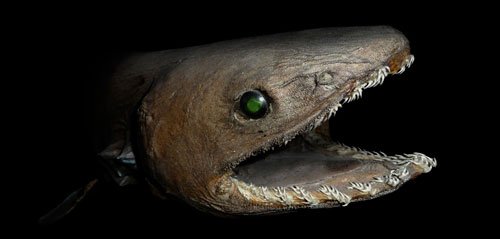Undiscovered monsters lurk in ocean depths

FROM THE COLOSSAL SQUID, which maybe be 14m or more in length, to the freakish-looking goblin shark, modern-day sea monsters exist in oceans all over the world. But could there be large, unknown species still lurking beneath the waves, waiting to be discovered?
To Dr Charles Paxton, an ecologist and mathematician from the University of St Andrews, Scotland, the answer to that question is an unequivocal “yes”. By studying the rate of past species discoveries, and projecting this into the future, he predicts that there are many more sea monsters still to be identified.
“I believe there are large animals – greater than 2m long – awaiting discovery by science,” Charles told Australian Geographic. “Why? Because we’re still finding them. There really is no doubt about that at all.”

This giant squid is more than 4m long, but the colossal squid, rarely seen, is much larger (Credit: NASA).
In fact, eight new species of large marine animals have been identified in the past 20 years, including a 3.4m bottom-dwelling ray (Bathyraja hesperafricana) that lives to depths of 2km off the east coast of Africa from Mauritania to Gabon.
Other examples are the Australian snubfin dolphin (Orcaella heinsohn), which was only officially described as a species in 2005 and is found all along the northern coast of the continent, and a new species of beaked whale (Mesoplodon perrini) identified off California in 2002.
Sea monster sightings
But what of all those old, unconfirmed monster sightings: of serpents like the Loch Ness Monster and tentacled beasts like the Kraken? Could they have been genuine reports of unknown species?
Charles doesn’t think so. He says most of these sightings are simple cases of mistaken identity, down to people not recognising known animals or misinterpreting objects in the water for monsters.
Nonetheless, the sightings can act as statistically important data, he says, revealing interesting things about human perception and the reporting process itself. “This is an example of where anecdotes can be used as data,” he says. “Monster reports tell us first and foremost about the monster reporting process and only secondarily about monsters.”

The ghoulish frilled shark, thought to capture prey by curling up and lunging forward like a snake, is one example of a living sea monster – it was only seen in its natural deep-sea habitat for the first time in 2004. (Credit: Citron/Wikicommons)
New insights into old monster sightings
Charles’ latest research, presented last week at the Zoological Society of London, looked at reports of unidentified large marine animals from 1758 to 2000. He found that most of the reports were not in fact mistaken sightings of objects or creatures in the far distance, as previously thought, but were actually much closer – usually less than 100m from the boat.
“It turns out that reported monsters appear to be closer than might be expected by chance alone,” says Charles. Determining the exact reason for this is difficult, but it could be due to biases in the reporting process. “People don’t report if they see something weird at huge distances – it’s more likely to be reported if it’s close,” he says.
Another finding was that second-hand and anonymous reports described monster sightings at even shorter distances, suggesting that these sorts of accounts may have been exaggerated to boost their credibility.
Most importantly, though, the research demonstrates that information as seemingly ‘unscientific’ as sea monster anecdotes can actually be studied scientifically to garner insights into the reporting process. And Charles believes further analysis of old accounts will yield more surprising results.
RELATED STORIES
In pictures: new deep sea creatures
10-year census finds thousands of new species
First video: Australian deep sea canyon
Sea monster gave birth to live young, fossil shows
‘Supergiant’ crustaceans found in ocean depths
10-year census finds thousands of new species
Deep-sea canyon discovered off WA
Deep-sea mud source of ’21st-century gold’
3-D maps reveal depths of sea floor
Australian oceans are more biodiverse




